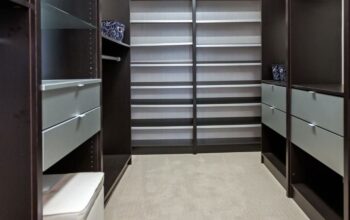Flat roofs are particularly popular for commercial buildings due to its compact design, lower costs, and ease of maintenance. But quite recently, more and more modern homeowners are opting for a unique and cost-efficient roofing design using flat roofs because apart from lower installation costs, flat roofs are generally a space saver. If you have a modern designed home, you can either use the space as an outdoor lounge overlooking the neighborhood while you spend the rest of the afternoon with your friends and family over barbecue and a few cans of beer. Surely, it’s going to be a fun afternoon for you, but if that’s not exactly how you’re planning to use the extra space, you can probably place your air conditioning units there or better yet, your solar panels.
Definitely, there are multiple ways you can make use of a flat roof. For commercial buildings, it’s widely known because there are fewer risks associated with its installation, labor costs are also lower and maintenance is fairly easy. Suffice to say that they are your best option if you have a commercial property, and they can also be reasonable for residential homeowners. But of course, like in any type of project, we want to make sure we are choosing the best material for our property without going over the set budget.
And so, to help you carefully plan for your roofing project, we have summarized the best roofing materials according to material, budget, and their expected lifespan.
Modified Bitumen
Cost: $
Maintenance: Low to Moderate
Lifespan: 10-15 years
From its name itself, a Modified Bitumen roofing material uses bitumen or asphalt as its primary base and reinforced with plastic or rubber ingredients. It’s a type of built-up roof where multiple layers of the compound are applied to strengthen the material and for added durability. Asphalt as we know it is a durable and weather-resistant material that contracts and expands during the cold weather season. However, despite being able to withstand hail, it is susceptible to cracking and blistering which cuts its service life to about 10 to 15 years. Nonetheless, it’s the most budget-friendly among all other flat roofing materials.
Ethylene Propylene Diene Monomer (EPDM) Rubber
Cost: $ – $$
Maintenance: Moderate to High
Lifespan: 20 years
EPDM is a type of low-cost lightweight synthetic rubber used in flat roofs. It’s almost comparable to TPO except that it’s all rubber. The primary advantage of using EPDM for your roofing is that it’s easy to install and the repairs are reasonably simple to do. Some owners would prefer to install it themselves but we highly suggest that you leave the work to a professional roofing company as improper installation can lead to gaps and uneven seams which can consequently result in moisture leakage and increased vulnerability to punctures.
Probably the biggest drawback of EPDM is unlike TPO, it’s not an energy-saver. In fact, it’s black color can trap heat and increase the room temperature inside. Nonetheless, they’re great for people who have a limited budget and are looking for an option with more homeowner-friendly repairs and installation.
Thermoplastic Polyolefin (TPO)
Cost: $ – $$
Maintenance: Moderate
Lifespan: 15-20 years
Thermoplastic Polyolefin or TPO is a newcomer in the roofing market, but it is considered as one of the often-used materials for commercial establishments. TPO is said to be a cross between PVC and EPDM because it contains rubberized plastic, skrim, and other chemical components that attributes to its pliability. TPO is a single-ply vinyl membrane that is usually welded together. You can easily tell it apart from other types of materials because it’s usually white in color and thus making it a good sun reflector. Meaning to say, it’s energy-efficient because it blocks off UV rays and prevents the heat from penetrating the structure inside.
If you take good care of it, it can last you for a good 15 to 20 years, however, since it is relatively new, manufacturers would come up with better innovations for TPO every now and then. In addition, it could also get quite taxing if your contractor failed to properly adhere the seams together during the installation because it can be highly prone to water leakage so we advise you to perform regular inspections.
Polyvinyl Chloride (PVC) Roofing
Cost: $$
Maintenance: Low
Lifespan: 20+ years
Polyvinyl Chloride (PVC) roofing is a single-ply roofing membrane that boasts resistance to chemical damage and other natural elements such as fire, strong winds, and even moisture. PVC’s are watertight and work better than other materials with broken seams where water and vapour can potentially pass through. PVC is commonly used in manufacturing facilities where chemical exposure is high which can likely corrode substandard roof materials. In terms of aesthetic and color options, you have a much wider selection with a PVC membrane because it comes in different colors although the most widely used are the lighter shades which have of course, a higher solar reflectivity.
Metal Roofing
Cost: $$$
Maintenance: Low
Lifespan: 35 years
Metal roofing is typically made out of aluminum material that is known for its durability and capacity to mirror the suns’ heat thus, keeping the indoor area crisp and cool all throughout the day. Although in terms of costs, metal roofing is perfect for those who have the budget to splurge a little more because while the original cost of material and installation can be quite an investment, you are guaranteed to reap its long-term benefits because metal roofs can last for up to 35 years compared to an average of 10 to 15 years for normal roofing materials.
Aside from durability, scrap metals from the metal roofing are fully recyclable so they’re also environmentally sound. As a matter of fact, 30% to 60% of most metal roofing materials are made from recycled matter so although you’ll be spending quite a fortune initially, you’ll certainly get your money’s worth in the long run. The only downside though is that in case of a roof replacement, your contractor would need to tear down your roof completely. Anyway, you wouldn’t want to deal with an old and rusty roof over time.
Planning for a roofing project can be daunting especially with a limited budget and so we hope that our list was able to help you narrow down your choices. And as our final reminder, remember to vet your roofing contractor before signing the deal. Make sure that they are who they say they are, and that they are skilled enough to make the installation. Cardinal Roofing and Gutters is a fully licensed and insured roofing company who has 50 years of expertise in the roofing business so you might want to check them out too.
Related Posts

Loves home. I am here to provide how to make your home a much better place. 🙂 Blogging about HomeDecor, Home Improvements and more.











